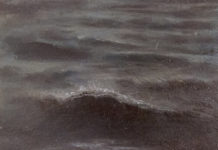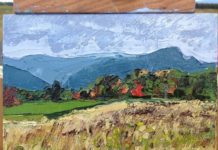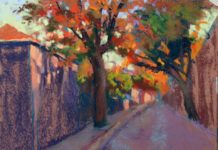
Why is Peggy Root, the First Place winner in the August/September contest in the PleinAir Salon, a devoted plein air painter?
“I’m allergic to the studio, I’m afraid,” she says, laughing. “I am comfortable in the woods. I’m comfortable outside. In the studio I tend to tighten up and it doesn’t go as well.” Root lives in the foothills of the Appalachian Mountains in Northeast Tennessee, where she paints, raises a family, and runs an art school with her husband, Tom Root, called the Root Studio School of Painting and Drawing. She goes out any day that she can and hikes to a few of her favorite views, painting in two-hour sessions over several days to complete her large canvases. “Small for me is 12″ x 16”, she says. “My aptitude with a brush means I need a bigger area. It’s one of the reasons why it takes me a while to finish a piece.” Large for Root means 40″ x 60″. At that point, the canvas can very easily act as a sail. “Yes, any larger and the wind catches it too much,” she acknowledges. “I will strap them to my vehicle or strap them to a tree.”

“Mt. Celo,” by Peggy Root, oil, 30 x 40 in. Courtesy Blue Spiral 1, Asheville, NC
Root says she paints small (for her) on the occasions when she’s finished a big painting and still has some daylight. But mostly she arrives on the scene equipped with a variety of canvases at various stages of development. If it’s raining, she will pull out a rainy-day piece and work on that. If the scene demands a format that she doesn’t have handy, she will get out her tools and canvas and stretch one on the spot. “People will see me on the side of the road banging on a stretcher,” Root says, laughing. “There’s nothing more aggravating than finding a scene that needs a particular format and not having the materials to do it. So I try to have them on hand.”

“March Afternoon,” by Peggy Root, oil, 36 x 40 in. First Place in the August/September contest in the PleinAir Salon
Clearly this artist is game. She reinforces a surveyor’s tripod with PVC pipes to use as an easel. She always carries a tarp, because you never know when you might need a tent. She rejiggered a jogging stroller to carry additional equipment. Her only rule is that everything must be able to go either over or under a barbed-wire fence.

“Farm at Red Hill,” by Peggy Root, oil, 30 x 60 in. Best Buildings in the August/September contest in the PleinAir Salon
Her process is a curious mixture of plein air speed and exacting deliberation. Root feels very strongly that she must truthfully depict the trees and other plants in her pieces, down to the way their leaves dangle. She isn’t bored after painting in a place a few times; Root is a repeat visitor to many locations. Yet in the fall, the colored leaves can drop overnight in one strong rainstorm. “I have to paint pretty fast,” she says. “In the summer I can slow down and take just as much time as I need to. My preference is to finish them outside, but sometimes all the leaves fall off or the snow melts, and I have to do some work indoors.”

“Late Sun January — Tavern Hill,” by Peggy Root, oil, 40 x 50 in. Courtesy Blue Spiral 1, Asheville, NC
Root has stories about her paintings. Sometimes it seems the stories suggest painting indoors isn’t such a crazy idea. She will tell of cows — protective mothers — chasing her over creeks, of calves mewling for help from holes in a field. And those are the easy situations. “You never know what you are going to get into, painting outside,” Root says. Her experience while painting “Farm at Red Hill” is excellent proof of that.

“Waterfall,” by Peggy Root, oil, 40 x 40 in.
“That was a very peaceful time, painting that piece — except for the closing day, when I had a close encounter with a timber rattler,” she says. “It was up in the mountains, a beautiful spot, with wonderful wildflowers. A wooded trail ran down to the house. The composition is in two parts, foreground and the shadow of the trail, and then down into sunlight. I was trying to balance those two things, and I remember battling it out for a while, with all that backlit foliage and very little sky. Sometimes those long compositions are difficult.
“The final day came, and I just needed to finish a few things on the painting. It was a 15-minute rigorous hike up to the hill. Suddenly, I heard something, and when I looked back, a timber rattler had struck at me and he was fully extended. It turns out I didn’t finish that day, but when I did come back, it was in bigger boots!”




